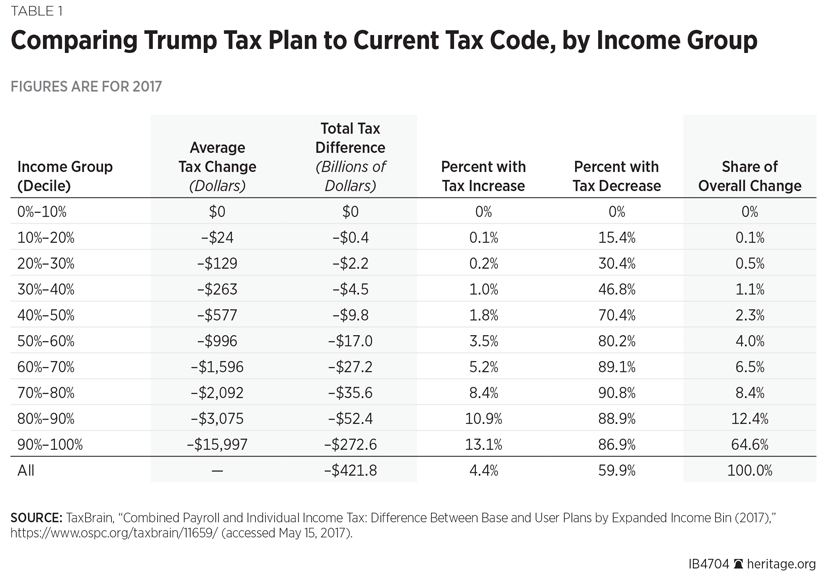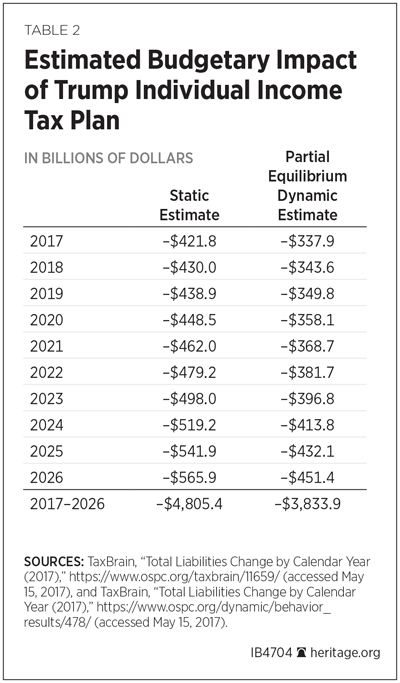In April, President Donald Trump proposed a broad outline of his preferred tax reform plan. His plan would cut taxes on the individual side of the tax code by an estimated $3.8 trillion over 10 years.
On the individual side, the proposal:
- Consolidates the current seven tax brackets into three, at tax rates of 10 percent, 25 percent, and 35 percent;
- Doubles the standard deduction, implicitly expanding a fourth 0 percent tax bracket;
- Repeals the estate tax, alternative minimum tax (AMT), and the 3.8 percent Obamacare surtax on net investment income;
- Eliminates “targeted tax breaks that mainly benefit the wealthy”; and
- Maintains the home ownership and charitable deductions.
On the business side, the proposal:
- Lowers the rate paid by all businesses (including traditional corporations and “pass-through” companies) to 15 percent;
- Makes the current worldwide system territorial by only taxing income earned in the U.S., with a one-time transition tax on profits currently held overseas; and
- Eliminates special interest tax breaks.[REF]
What We Can Model
Using the Open Source Policy Center’s online interface, TaxBrain, we modeled changes to the individual income tax. The modeled changes included:
- New personal income-tax schedule;
- Fifteen percent pass-through income-tax rate;
- Repeal of the AMT and of the net investment surtax;
- Doubling of the standard deduction; and
- Elimination of all itemized deductions except those for mortgage interest and charitable giving.
The new personal income tax schedule simply combines the first two current brackets to make a 10 percent bracket, the middle three brackets are collapsed into a 25 percent bracket, and the remaining top two make up a 35 percent bracket.[REF] The proposal as presented to the public did not specify income brackets for the reform.
Notably, we did not model any changes to the corporate income tax. Similarly, we did not model “tax relief for families with child and dependent care expenses.” Thus, this Issue Brief is an analysis of only one part of the President’s tax proposal.
TaxBrain is built on a microsimulation model of the individual income tax. Using anonymized Internal Revenue Service records from previous years, it computes the tax burden for each simulated tax unit under existing law and under the proposed reform. Then it adds up the changes across tax units to get the aggregate revenue effect.
Static Results
On a static basis (i.e., not accounting for behavioral or economic effects), the tax changes would decrease revenue by $422 billion in the first year and by $4.8 trillion over 10 years.[REF]
The proposed tax plan would provide a tax cut for the average person in every income decile. The largest benefits would go to those taxpayers in higher income brackets. However, a significant minority of high earners would pay more in taxes. A rough approximation of the average tax change as a percent of income is between 1 percent and 2.5 percent for most taxpayers.

Partially Dynamic Results
TaxBrain allows users to alter aggregate behavior by taxpayers in a “partial equilibrium” model using three parameters. The outcomes of this exercise likely fall in the range that fully dynamic economic models would give, but do not have the rigor of a fully dynamic score. For example, the partial equilibrium model does not distinguish between cutting taxes via a loophole and cutting taxes by lowering rates for everyone. A well-designed dynamic model would treat different types of tax cuts differently.
TaxBrain’s three parameters are:
- Income elasticity of taxable income. When people are richer, economic theory predicts that they consume more and work less. We set this parameter equal to –0.135, an estimate obtained by Jonathan Gruber and Emmanuel Saez.[REF]
- Substitution elasticity of taxable income. When income taxes fall, the reward to work rises, so people work more and earn higher taxable incomes. They also spend less effort structuring income to avoid taxes. This is the key lever in the model. Following Gruber and Saez we set it to 0.43.
- Elasticity of long-term capital gains. At higher tax rates, business activity and capital gains decrease. We follow the Joint Committee on Taxation and the Congressional Budget Office and set the parameter at –0.79.[REF]
This simple model causes taxable income to increase, yielding higher revenues than under the static model. TaxBrain takes into account increases in payroll tax revenues that result from the higher incomes. State coffers would also benefit from the increase in taxable income, although TaxBrain does not take that into account.
Using the partial equilibrium model, the modeled tax reform decreases revenue by $338 billion in the first year and by $3.8 trillion over 10 years.[REF] The budgetary impact is 20 percent less than under the static case.

The Best Is Yet to Come
Although corporate-income-tax reforms may represent a small share of tax reform’s revenue reduction, they represent the largest potential economic growth gains.
A 15 percent corporate tax rate would significantly increase economic growth. The Tax Foundation has estimated that lowering the top corporate tax rate to 15 percent would permanently increase gross domestic product (GDP) by 4.3 percent in the long run, and decrease 10-year revenues by less than $1 trillion.[REF] Additionally, about 3 percentage points of the rate reduction could be offset by repealing business-tax preferences.[REF]
Even more effective at spurring growth than corporate-tax-rate cuts—but regrettably not included in this draft of the Trump Administration’s tax plan—is expensing of new business investment. Where corporate-tax-rate cuts benefit growing and shrinking businesses alike, expensing is targeted at sectors that are creating jobs and investing in new equipment.
The Administration’s tax proposal should be refined and improved to focus primarily on increasing economic growth and job creation. That means modifying the proposal to include expensing of new investments, even at the cost of trade-offs along other margins.
Finally, tax reform should be pursued within a holistic conservative framework for public finance, one that puts a priority on achieving budget balance in the medium term, as Heritage Foundation research has consistently concluded.[REF] That requires serious reforms to entitlement programs and a substantial reduction in the activities of the federal government. Only a small government can be supported by low taxation.
—Adam N. Michel is Policy Analyst in the Thomas A. Roe Institute for Economic Policy Studies, of the Institute for Economic Freedom, at The Heritage Foundation. Salim Furth, PhD, is Research Fellow in Macroeconomics in the Center for Data Analysis, of the Institute for Economic Freedom.


